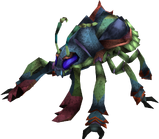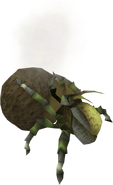Template:2007 page Kalphites (a.k.a. the Kalphiscarabeinae) are a species in RuneScape that resemble a mix of scarab beetles and cockroaches. The normal hive is located west of the Shantay Pass and is located north of the Bedabin Camp (a Fairy ring BIQ can be found near the entrance), and their nursery is north of the main hive. The hive of the Exiled Kalphites is located south of the Jaldraocht Pyramid and north of Menaphos.
Types
Normal
- Kalphite King (level 2500)
- Kalphite Queen (level 333)
- Kalphite Guardian (level 72)
- Kalphite Soldier (level 65)
- Kalphite Worker (level 58)
Exiled
- Exiled Kalphite Queen (level 356)
- Exiled kalphite marauder (level 98)
- Exiled kalphite guardian (level 98)
- Exiled kalphite paragon (level 84)
- Exiled kalphite soldier (level 84)
- Exiled kalphite worker (level 75)
Other
Background information
The kalphites are the biggest known insects in all of Gielinor. They are related to beetles and scorpions, are green in colour, and have remarkable antennae which can detect the slightest movement. Their carapace consists of armoured plates called lamellae. The shell can be compressed into a ball. They also use it to sense odours by fanning the carapace out like leaves. They use their front legs to dig enormous tunnel networks which they use as their nests. The Kalphites exist in a caste-based society, very much like bees.
The lowest of all ranks are the larvae. The Kalphite larvae are newly hatched Kalphites, but will develop into one of the bigger ranks fairly quickly. Unlike the other kalphites, larvae are completely harmless to humans and run away from them rather than fighting them. They are very hard to catch and are often chased with the help of a cat.
The larvae can develop into workers. The job of the Kalphite workers is to take care of the newly laid eggs, which contain new larvae. They also provide the hive of food, and a pack of workers can strip the flesh off a fully grown camel within only a few seconds.
Larvae can also develop into soldiers. The soldiers' job is to protect the hive from any danger and are more developed to fight. Unlike the workers, soldiers are poisonous, bigger, aggressive and have spikes on their antennae and legs.
After the soldiers come the guardians. Guardians are even stronger and bigger than soldiers and have more and bigger spikes on their antennae and legs. Their job is to protect their queen from danger and they are often located close to her, very deep in the hive.
The final and highest stage of kalphites are the queen and the king, the most powerful of all. The queen's job is to lay small brown eggs which contain new larvae.
Since the queen is the only kalphite that can lay eggs, a hive cannot do without one. The kalphite queen is one of the strongest kalphites and has, unlike other kalphites, powerful spines on her abdomen which can be launched to those who dare to approach her. She has no spikes on her antennae, which are instead developed to cast magic spells. She also has the ability to use what appear to be protection prayers, however, this has been described as a natural immunity to certain attack styles. The kalphite queen has two forms. The first form has a green armoured shell, similar to other kalphites. Once the first form is defeated, the queen will break out of her armour, emerging in her second form. This second form looks very different to other kalphites, with red colour and wings instead resembling a giant wasp. When a queen dies, one of the larvae quickly develops into another one. This makes it very difficult to slay a full hive of kalphites.

A statue of Scabaras, the possible creator and/or leader of the Kalphites.
The Kalphite King, only found in the Exiled Kalphite Hive, is the strongest of all kalphites. He is far larger than other kalphites and has an orange carapace. He also has small wings, however, he is not known to be able to fly. He is capable of using many abilities that players can use, such as incendiary shot and slaughter, and is also capable of digging. The colour of his wings changes randomly and indicates the attack styles used. They are yellow, green or blue for melee, ranged or magic, respectively, and this also changes his weakness. He has a very dangerous special attack in which one of the players fighting it will turn green. This player will be killed instantly after a few seconds, unless another player uses provoke to draw the king's attention away from them. He is also capable of surrounding itself with a healing aura which allows him to heal from the damage dealt or taken, depending on the colour of the aura.
There is also a Summoning familiar known as the spirit kalphite. It can be summoned with 25 Summoning. The spirit kalphite can hold 6 items and has a special ability named Sandstorm, which attacks 5 nearby opponents with 20 life points. A spirit kalphite looks different than other kalphites, having a blue colour and no antennae.
The origins of the kalphites are unknown, but many people say that they were created when the desert god Scabaras accidentally dropped some of his blood on some scarabs, turning them into kalphites. Some people, mostly the scientist, don’t believe this theory and go for a more natural theory.
Role in game
A map of the kalphite lair. (Click to enlarge).
Kalphites can only be found in two locations. The first is the kalphite lair, which is located west of the Shantay pass in the Kharidian Desert. Players who want to enter the lair the first time should bring a rope to access the hive, this is needed only once because the rope is left at the dungeon entrance for later use. The lair consists of three chambers. The first one contains larvae, 11 workers, 6 soldiers and 2 guardians. at the end of the room is the entrance to the second room. The second room contains the queen, 6 workers and 2 other guardians. Players need another rope to enter this room, this is also needed once. The third and final room is unlocked during the Do No Evil quest. It contains 6 soldiers and another 2 guardians. Players can enter this room through two different entrances. One is found at the north of the second room (watch out for the queen). Another is hidden in a rock just outside the hive and is located south of the main entrance. The desert heat effect from the desert is not present in the lair.
Larvae can be found everywhere in the lair. Unlike the other kalphites, larvae are not attackable and mostly act as entertainment and decoration. When getting close to a player, larvae will run away. Their only use is that they may be caught with a cat. It's possible to turn lazy cats into wily cats (after rat catchers) by catching larvae. However, players almost never do this and prefer catching rats to make wily cats. Mostly because catching rats is much easier, as those don't run away from you.
Dung kalphites are a special type of kalphite larvae found in the Kalphite nursery. Unlike the larvae in the main lair, dung kalphites can be attacked by the player.
Kalphites are often given as a slayer task. Since the kalphites come in a great variety of levels, every slayer master can assign them. During a slayer task, any of the slayable kalphite varieties will count, except for dung kalphites. Training on the kalphite workers is regarded by many as one of the better ways to train slayer due to the vast array of useful tactics for killing them.
Workers can also be found everywhere except in the third room. They have a combat level of 58 and 4200 life points. Many players kill kalphite workers for slayer, because those are the easiest to defeat. The best place to kill workers is in the room right at the entrance because there are no other kalphites to interrupt you. Many players kill their workers here so it's often crowded in that room.
Soldiers can be found deeper in the hive. Their combat level is 65, they have 4,700 life points and unlike workers,

A kalphite soldier in a player owned house dungeon.
they are poisonous. Stronger players sometimes kill soldiers for slayer because they give more slayer experience. However, anti-poison potions or an anti-poison totem are needed to fight them so some stronger players still choose the workers instead. Kalphite soldiers can also be used as a guardian in treasure rooms in player owned houses.

Players often hunt for the kalphite queen so they can mount her head in their house.
guardians can be found at the end of the first room and in the second and third one.
The kalphite queen is mostly killed for other reasons than slayer, as she is very difficult to defeat. She is mostly hunted down for a dragon chainbody, which she is able to drop. The queen also has a chance to drop a KQ head when killed, this head can be stuffed at the taxidermist in Canifis and then mounted in a skill hall in a Player owned house. Players can also kill her to complete special slayer challenges, or just for the honour. The Kalphite Queen uses all three combat styles and protection prayers. She has a combat level of 333 and comes in two forms. Each form has 40,000 life points.
The second location where kalphites can be found is the Exiled Kalphite Hive north of Menaphos. This is filled with kalphites who broke away after a second kalphite queen was exiled. Among the exiled kalphites is the powerful Kalphite King.
Keris
Keris is a dagger which is given as a reward for completing the Contact! quest, it has a strong side-effect on kalphites. On a rare occasion, when fighting any kalphite, it will cut into a chunk of the kalphite's Chitin and do triple the damage it would normally do. However, this is a very rare thing to happen, and since it only happens to one type of monster, different weapons are commonly preferred.
Gallery
Trivia
- Despite being cited as insects many times in RuneScape, kalphites have bones, which can be seen strewn throughout their lair in the Kharidian desert identified by the examine text as "kalphite remains". One of the defining characteristics of all insects is that an exoskeleton is present as opposed to bones; arguably this means that the kalphites are not actual insects; unless this is meant to imply the remains that kalphites leave behind (only bones of their prey).
- Kalphites have a structural like rule, and may be inspired by ants as they both have many same qualities. Kalphites and ants are put into different roles for the hive, and if the queen of the hive dies, another queen will quickly take their place.
Kalphites | |
|---|---|
| Standard | |
| Exiled |
|












